History of Leicester Forest East services
< return to Leicester Forest East
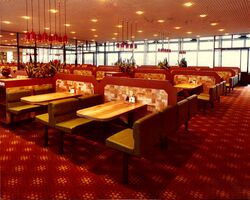
Red furnishings inside the main restaurant in the 1970s.

This was a special feature presented as a story on the service area's 50th birthday.
In 1962, the Ministry of Transport were looking at possible sites for a service area on the newest part of the M1 motorway. Their search didn't start well: the Ministry looked at Watford Gap and worked out where the next service area should be, and it took them to an urban area by M1 J21. Several options were assessed and none were great. But the outskirts of Leicester Forest East was chosen as the least-bad option for service area 17.
This was still early days for motorway service areas and for the motorway network. Service area 17 doesn't imply there were 16 service areas before it (there were 11, the Ministry's counting was optimistic at best). That internal working title did however prove to be catchier than the eventual name of "Leicester Forest East motorway service station"!
What Wasn't To Be
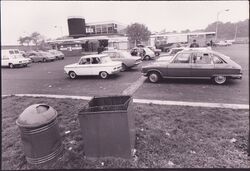
Seven names put themselves forward for the task of operating Leicester Forest East, each with their own ideas.
The Fosse Motor Company of Desford, who had no motorway experience at all but knew quite a bit about filling stations, thought they could be the ones to make this site work. Unfortunately their inexperience showed and it was an easy one to rule out. Their idea of having one long canopy crossing the motorway and bringing all the buildings together was strong and simple. They would have sat diners alongside the motorway which even then wasn't seen as ideal. They planned to lease out to a catering company the actual restaurants: one was waitress service, one was self-service and one would have been a hybrid between the two. It just didn't really gel.
Kenwell Motor Services also wanted to be the operator. It would have been their first time but they had experience in helping Fortes run Barnsdale Bar. Despite this, their plans were summarised as being extremely poor. At the time, having two separate amenity buildings was seen as unnecessarily expensive. The style wasn't really what they wanted. But most importantly, their proposals were so vague the inspectors weren't really sure what they were inspecting!
Blue Star were part-owners of Motorway Services Ltd (now Welcome Break - watch out for that name). Having let the Ministry down with their last two operations, Motorway Services Ltd didn't want to get back on the horse, so Blue Star thought they'd go it alone. This was brave for another company whose only contribution to service stations so far had been putting fuel in the pumps, but they came back with something truly modern, something that had clearly been designed by a competent architect.
There were two mirroring buildings, a grill and griddle restaurant with timber strips lining the roof. A large free-standing staircase took customers up to the entrance hall, shop and restaurant from a paved downstairs area. Toilets were downstairs and a bridge plugged into the entrance hall at each end. Outside, the building would have been covered with steel and glass. Away from all the glitz, Blue Star were the only rejected proposal to offer a thorough and effective financial proposal, which was just as important. It was a really good effort, and then the inspectors turned the page. Their proposal for a one-size-fits all restaurant and menu was "unsuitable", and really "very poor". That cost them dearly.
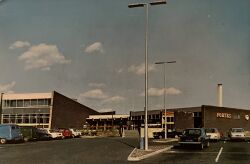
Blue Star did not know that their fellow co-owners felt exactly the same way, and Fortes (now part of Welcome Break - hmm) had submitted a bid too. They made use of the embankments by having one small building at bridge-level, much like Medway. It "had the hall mark of the experts". But something wasn't right: Leicester Forest East deserved something bolder, something which could live up to its long name.
If it was inspiration you needed, Top Rank had their name written all over this. They were so keen to get involved, they bid twice. "Rank A" had two different restaurants on each side of a bridge, and a kitchen in the middle. Their large expanses of tarmac outside reminded Ministers of the worst parts of Watford Gap. "Rank B" was similar but without the bridge, creating two small and difficult to operate amenity buildings. Top Rank had a habit of coming up with ideas so ambitious they could never afford to pay the Ministry back, and this time the Ministry steered well clear.
The Final Two
If none of those proposals sound like the modern-day Leicester Forest East to you, that's because there's still two more to go. One of them won the contract - and the other came very close.
Granada
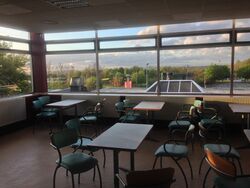
Granada had just opened Toddington and were about to bid for Frankley. Even 30 years before their infamous monopoly, they believed that biggest could be best. Toddington was the biggest service station around when it opened, and another big one just a short way up the road could be exactly what they needed to squeeze the others out.
They proposed an "extravagant" building on the east/southbound side only. With an 840 seat restaurant, two 112-seat transport cafés (one for each side), a snack bar (an early Greggs effort), a lounge and a café; they meant business. On the northbound side, space was left for an eventual amenity building.
Initially they wanted an uncovered bridge to link the two sides, but they reluctantly accepted a covered walkway would be necessary: this would have led to a concourse area where the upstairs restaurant and toilets were. Downstairs was a shop, post office, more toilets and a kitchen. Their large range of facilities appeared to be subtly aimed at local pedestrians while Granada waited for motorway traffic to pick up.
The restaurant intended to set a very high standard, with a deep carpet and woodblock flooring. The less pricey cafés would have been in bright colours.
Not all their big ideas were clever. The large first-floor restaurant promised great views of the surrounding area (much like Frankley southbound), but they also proposed large trees which would have blocked the view. It was all a bit bulky. And the Ministry knew full-well an 840-seat restaurant on a brand-new motorway would close straight away due to low demand. Considering this, although they had offered the Ministry impressive financial returns, the Ministry weren't convinced Granada proposal had actually offered themselves any room to make any money - and that would be a gamble.
There were several groups responsible for choosing the winning bid, and the Department for Transport backed Granada.
Ross
The Ross proposal was designed by Howard V Lobb & Partners. It won design points straight away by proposing to put the petrol stations by the exit. Experience had shown that this was the way to go, but most proposals still hadn't got the message.
The idea of putting outdoor terraces - shielded slightly from the motorway - at each end of the two-storey bridge-come-amenity building was a new one, and one that scored more points. They even considered raising the entire southbound car park just so it would meet the entrance at bridge-level, but their decision to back down on that one allowed for some more sensible financial proposals.
On the bridge, there was a covered walkway on the north-facing side, and a 690-seat Captain's Table restaurant on the south-facing side, which was designed by Terence Conran. It was positioned on this side as the view to the south was better. The Motorgrill restaurant intended to be luxurious but not expensive, and would have a deep, luxurious carpet.
The steps up to the bridge stuck out at each end, enclosed in a glass case which can still be seen today. The main entrance was somewhat discreet, hidden underneath each terrace. Away from the building were two transport cafés, which were slightly isolated. Between them, on each side of the road, was a fairly large patch of grass - something rarely seen in 1960s architecture, especially not when talking about motorways. Despite its appearance, most of the main building doesn't actually directly touch the motorway, which was a real maintenance boost that many predecessors hadn't considered.
The building was designed by Howard V. Lobb & Partners, who's plaque is inside the main building. The Minister in charge still liked bridge restaurants, and the Landscape Committee and Leicestershire County Council's architect both preferred Ross's.
Also impressive was its name. Frozen food retailer Ross had been intrigued by the motorway industry and wanted to get involved as it seemed like a novel way to market themselves. They were guaranteed to provide good catering as that is what they do as a business. From the start, the Ministry had wanted to invite relative newcomers into the service station industry but very few had avoided making major mistakes. And here was Ross, making the final short-list. They won the contract.
Opening a Legend
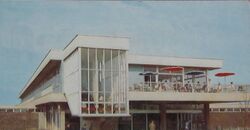
Sir Cyril Osborne MP attended an opening ceremony on 6 May 1966. The service area fully opened on 15 May, following Ross's £1million investment (around £16million in 2025). Its five-star, fine-dining offer was an instant hit with motorway users and local residents. It was very-well furnished: with not many service stations or local 24-hour buildings in place at the time, a few weeks after opening the service area was raided by criminals, who stripped the building of only its furniture.
The Captain's Table had a menu that changed weekly, themed around a different country that Ross's imaginary cruise liner could pretend to be visiting. Ross promoted it widely, using slogans such as "Leicester's restaurant with a difference", "a real place to celebrate" and "Europe's most advanced motorway dining spot". Reservations could be made by phone, even for their Christmas Day menu.
Excitement brimmed in the architecture, too. A short water tower continues to be used for marketing: Welcome Break reckoned changing their logo to KFC's increased sales by 10-15%.
After a few modifications, inside were bright colours and gleaming stainless steel. Staff wore sailor suits and red settees were used in the café, while the restaurant had a horseshoe counter with a kitchen in the centre. A Which? review of motorway service areas concluded that Leicester Forest East had the only decent restaurant on the motorway network.
At the time all new motorway service areas were grand, but Ross applied a finish which put Leicester Forest East well above the rest. It was proof that the tendering process can work - and what a result it was.
End Of The Honeymoon Period
With more motorway service areas opening in the following years, motorway dining stopped being a novelty. Trowell had just opened up the road and also promised a unique dining experience. Elsewhere, with rival operators taking away and cutting down on facilities, customers' interest in Ross's fine-dining waned and caused them to cut back on operating costs - with disastrous results.
Quality at Leicester Forest East dropped dramatically, and with new service areas continuing to open, it had absolutely no unique selling point. Waitress service moved towards unreliable automatic catering. Even the terrace was forced to close and the walkway was adopted by the main amenity building, bringing some life into the dead restaurant.
Deadlock
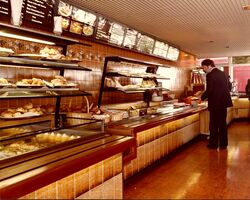
Ross looked at their own finances and reputation, and were not pleased with the situation they had got themselves in. To reduce the damage they renamed their motorway operation to "Motoross" and in 1969, they refused to build any more motorway service areas at all, until the government changed the way they are regulated.
Their protest didn't work, and Ross instead decided to join the rest, and gave their beloved service area a betting shop, ice cream stall and a separate Happy Eater restaurant in the old transport café. At a time when motorway service areas were accused of being low-brow and offering terrible food, the best Ross could offer was to be one of the same.
View the Leicester Forest East restaurant menu (June 1977, remastered)
Another change Ross made was trialling the first motorway conference room, in 1972. In 1977 Egon Ronay rated the service area as poor, but did concede that the main restaurant was "borderline acceptable". He said it was "attractively designed" but the convenience food was a let-down, especially the "hamburger which could have been made of anything".
The parking areas were expanded, resulting in much of the grass space being lost. More generally, the Department of Transport called the facilities "inadequate".
Keeping It Going
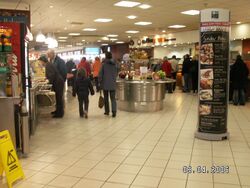
It all became too much for Ross, and in 1984 the service area was sold to Hanson Trust who decided to bring back the name they had been saving for a special occasion, Welcome Break. The service area was praised in Egon Ronay's Just A Bite guide, calling it "outstandingly good", praising the food, cleanliness and wide choice. It had a burger bar, pie parlour, fish bar, self-service cafeteria and restaurant.
Welcome Break soon fell under new ownership, which meant they were just a service area operator. They were one of three big ones, and they were corporate in their nature. Gone was the stylish fish restaurant and instead there was a pizza shop, ice cream kiosk, burger bar named Burger Break and a northbound Happy Eater. A second Happy Eater opened on the bridge, but was soon converted to Little Chef, giving a choice of both names side-by-side.
The outdoor Happy Eater was converted to Little Chef in 1989. Unfortunately (and ironically), this had a sign outside asking lorry drivers not to come in, despite being next to the HGV parking area and in the old transport café. There was also a KFC and Thorntons in the northbound building, and The Granary on each side.
A brief flirt with Granada saw Burger Break become Burger King, and then Little Chef became Red Hen. Practical but significant extensions saw single-storey areas expanded into the car park. Unusually, a coach company (Wallace Arnold) had an office on the southbound side.
Try as they might, Welcome Break couldn't hide the quirky features and ageing looks which plagued the service area. For several years you couldn't leave the facility without walking through the shop: this wasn't by design, but they didn't have enough space for a corridor. This was made worse by the fact that most of the facilities were upstairs, again because there wasn't a lot of room. Originally blue in colour, this scheme lasted some time, until a few corporate experiments saw it painted Coffee Primo orange and KFC red.
In December 1999, Welcome Break opened their first Days Inn motel here, by rearranging the road and parking layouts and demolishing the former transport café. Rooms would cost £45 per night (around £84 in 2025).
As a quirk of it being a former Ross site, the petrol stations were branded BP (though they sold Shell diesel for some time). Welcome Break purchased them in 2018, and replaced them with new Shell forecourts. They then changed to Welcome Break's own brand in 2020.
When Welcome Break introduced their Starbucks drive thrus, the southbound side replaced the remaining transport café building in 2019, while the northbound side had replaced an old police building in 2016.
The Ongoing Fight
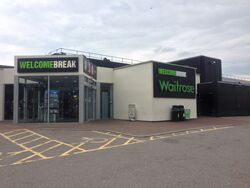
Leicester Forest East had even more problems surrounding it.
It was announced in 1989 that the M1 would be widened and a new J21A would be built. An internal report said that this project would "knock out or bypass" the service area. At the time, motorways were normally widened by building a whole new road, and this wouldn't be possible with the service area building being so close to the existing alignment - and that was before the complications caused by the new junction were factored in.
In the end, it was decided to squeeze the new junction and extra lane around the service area, which was completed in 1995. While the compromise worked, it has made the area very constrained, with no space for any further improvements.
It was announced in 2007 that the M1 was going to be widened again, and that J21 was going to be expanded. A number of options were drawn up which showed parts or even all of the service area needing to be demolished. This received considerable online attention, with the media calling the service area "Leicestershire's best known landmark" - a credit to the county architect who approved it.
That project was soon cancelled due to budget cuts, but as the problem hadn't gone away it was inevitable that it would resurface. In 2020 it was announced that a new scheme would be developed with a possible start date in 2030; this was part of a package of schemes which were soon lost among more budget cuts.
Separate to that, the draft vision for Whetstone Pastures suggests a new motorway service area could be built a few miles south of here. It's not impossible that one day the two visions will combine.